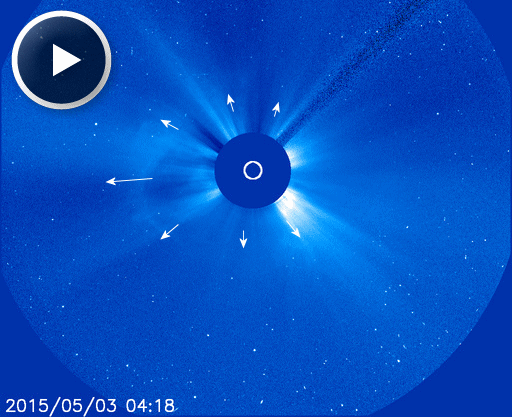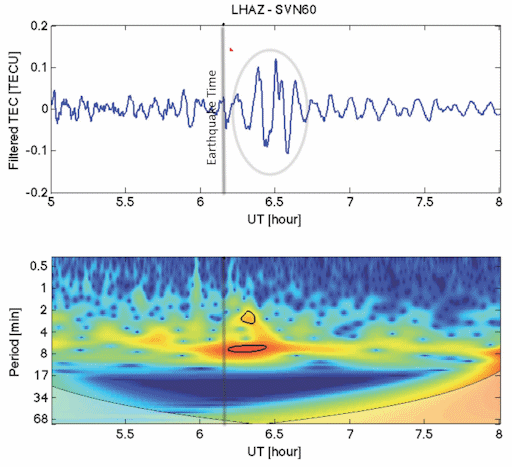Come to Tromsø and share Marianne's passion for rural photography: Chasethelighttours.co.uk invites you to experience "Heaven on Earth" with an aurora, fjord, fishing, whale watching, photography or sightseeing tour. | | |
FULL FLOWER MOON: There's a full Moon tonight and according to folklore it has a special name: the "Flower Moon." In the northern hemisphere, spring flowers are abundant in May, and the full Moon illuminates them beautifully after sunset. Take a look! [photo gallery]
METEORS FROM HALLEY'S COMET: Earth is entering a diffuse stream of debris from Halley's Comet, source of the annual eta Aquarid meteor shower. Last night, NASA's network of all-sky meteor cameras detected 5 eta Aquarid fireballs over the USA. This one was bright enough to see through the glare of the waxing full Moon:

The shower is expected to peak on May 5-6 when our planet passes through the heart of the debris stream. Unfortunately, not all of the eta Aquarids are fireballs. A typical meteor from Halley's Comet is about as bright as the stars of the Big Dipper--not so easy to see in the glaring moonlight.
Nevertheless, sky watchers could still see dozens of meteors. The best time to look is before before local sunrise on May 6th. Eta Aquarids are fast, moving at 66 km/s (148,000 mph), and often trace long bright paths across the sky. Set your alarm and enjoy the show.
Realtime Meteor Photo Gallery
CME, POSSIBLY EARTH-DIRECTED: A magnetic filament snaking around the sun's southern hemisphere erupted on May 3rd. The blast did not create a pulse of electromagnetic radiation (i.e., a solar flare), but it did hurl a CME into space. The Solar and Heliospheric Observatory recorded the expanding cloud:

Although the CME is not moving directly along the sun-Earth line, it might still be geoeffective. A glancing blow is possible on May 5th or 6th. NOAA analysts are evaluating this possibility as they receive additional coronagraph data. Stay tuned for updates in the hours ahead. Solar flare alerts: text, voice
Realtime Space Weather Photo Gallery
THE NEPAL EARTHQUAKE AND SPACE WEATHER: High above Earth, more than 60 km above sea level, there is a layer of our planet's atmosphere called "the ionosphere." It is where UV radiation from the sun strips electrons away from the atoms of normal air, creating a zone of charged gas that envelopes the globe.
The ionosphere is very sensitive to solar storms. Turns out, it can be sensitive to earthquakes, too. NASA is reporting that the magnitude 7.8 earthquake in Nepal on April 25th created waves of energy that penetrated the ionosphere and disturbed the distribution of electrons. Note the wave pattern, circled, in the upper panel of this ionospheric electron density plot:

Basically, these are waves of electron density rippling from a point in the ionosphere above the epicenter of the quake. The waves were measured by a science-quality GPS receiver in Lhasa, Tibet. It took about 21 minutes for the waves to travel 400 miles between the epicenter and the GPS receiving station.
The bottom panel of the plot is a "dynamic spectrum." Note the hot spots outlined in black. They show that the ionosphere was ringing with periods of ~2 and ~8 minutes. Presumably, these "tones" are related to atmospheric pressure waves billowing up from the trembling Earth below.
The ionosphere is the stage upon which much of space weather plays out. Auroras, meteors, and noctilucent clouds all occur there. The "Ionosphere Natural Hazards Team" at JPL studies how Earth itself affects this stage via earthquakes, volcanoes and tsunamis. You can read their report about the Nepal earthquake here.
Realtime Aurora Photo Gallery
Realtime Comet Photo Gallery
Every night, a network of NASA all-sky cameras scans the skies above the United States for meteoritic fireballs. Automated software maintained by NASA's Meteoroid Environment Office calculates their orbits, velocity, penetration depth in Earth's atmosphere and many other characteristics. Daily results are presented here on Spaceweather.com.
On May. 3, 2015, the network reported 8 fireballs.
(5 eta Aquariids, 3 sporadics)

In this diagram of the inner solar system, all of the fireball orbits intersect at a single point--Earth. The orbits are color-coded by velocity, from slow (red) to fast (blue). [Larger image] [movies]
Potentially Hazardous Asteroids (
PHAs) are space rocks larger than approximately 100m that can come closer to Earth than 0.05 AU. None of the known PHAs is on a collision course with our planet, although astronomers are finding
new ones all the time.
On May 3, 2015 there were potentially hazardous asteroids.
Notes: LD means "Lunar Distance." 1 LD = 384,401 km, the distance between Earth and the Moon. 1 LD also equals 0.00256 AU. MAG is the visual magnitude of the asteroid on the date of closest approach. | | The official U.S. government space weather bureau |
| | The first place to look for information about sundogs, pillars, rainbows and related phenomena. |
| | Researchers call it a "Hubble for the sun." SDO is the most advanced solar observatory ever. |
| | 3D views of the sun from NASA's Solar and Terrestrial Relations Observatory |
| | Realtime and archival images of the Sun from SOHO. |
| | from the NOAA Space Environment Center |
| | the underlying science of space weather |

